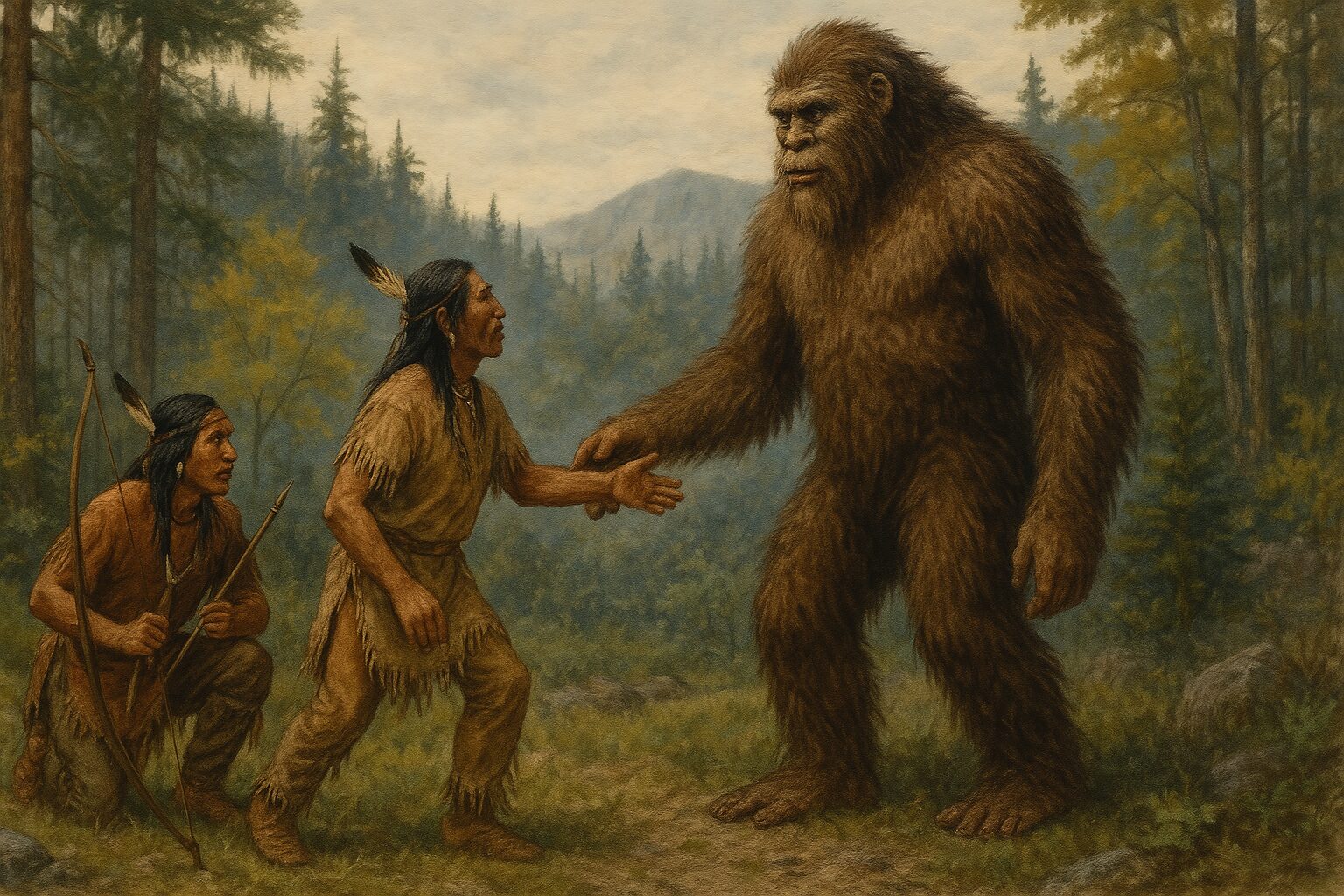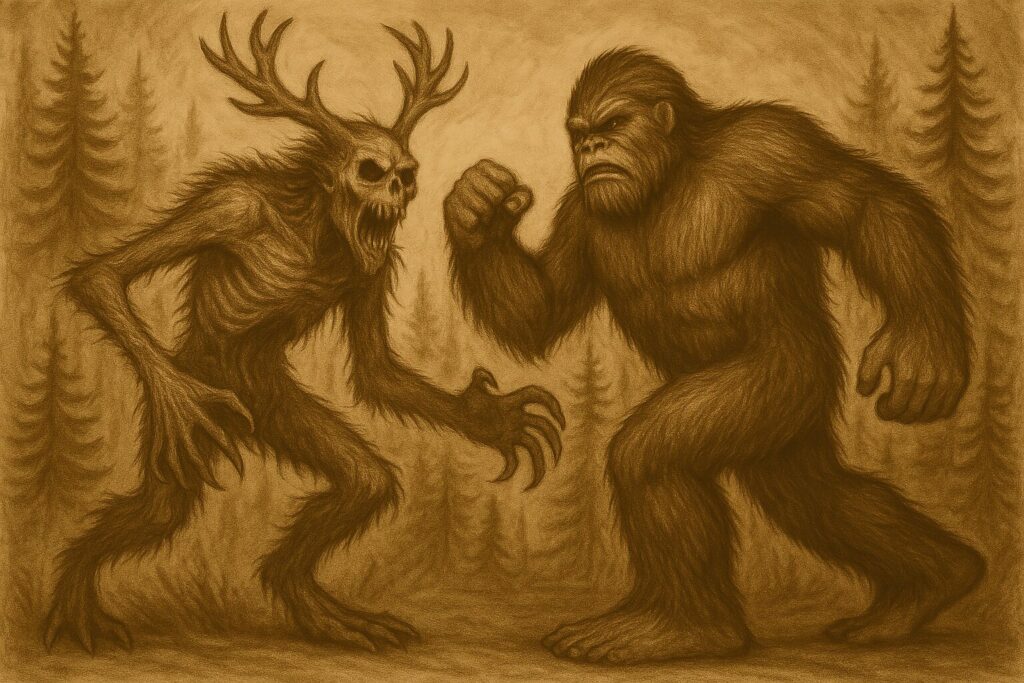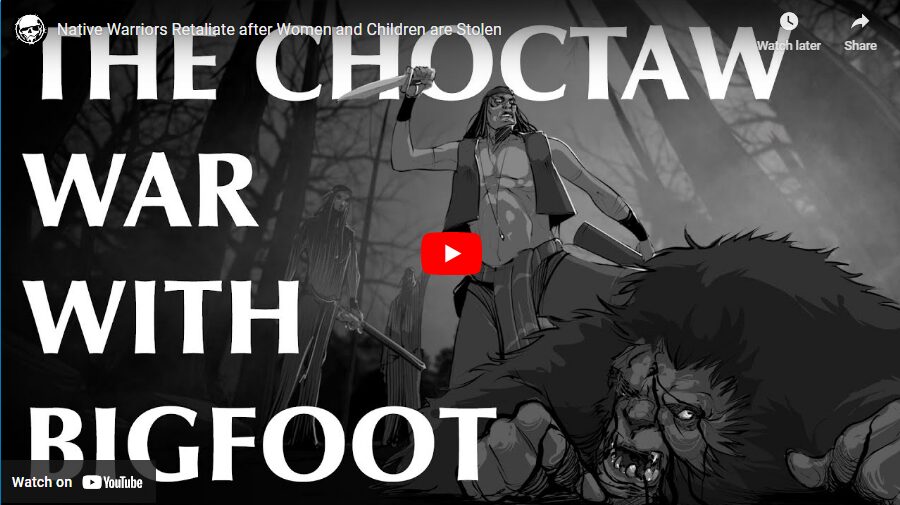
Native American folklore is rich with stories of Bigfoot-like creatures, many of which are lesser known but deeply fascinating. Here are a few intriguing examples:
- Ts’emekwes (Lummi Tribe) – The Lummi people of the Pacific Northwest tell of nocturnal, hairy giants that dwell in the mountains and forests. These beings are said to be shy but powerful, avoiding human contact whenever possible.
- Seeahtlk (Shoshone Tribe) – In the Great Basin, the Shoshone speak of a dangerous creature that roams the high desert. Seeahtlk is described as a powerful being that should not be provoked.
- Mayak Datat (Yokut Tribe) – The Yokut people of California have stories of the “Hairy Man,” a large, human-like figure covered in fur. Some legends depict Mayak Datat as a protector of nature, while others warn of its unpredictable nature.
- The Bigfoot War of 1855 – This lesser-known legend tells of a violent conflict between Native American tribes and Bigfoot-like creatures. According to the tale, a group of warriors fought against these beings in a battle that has since faded into obscurity.
These stories, passed down through generations, offer a glimpse into the deep cultural significance of Bigfoot-like beings in Native American traditions. They are not merely myths but part of a broader understanding of the natural world and its mysteries.
Ts’emekwes (Lummi Tribe)
The Ts’emekwes are a fascinating part of Lummi folklore, deeply rooted in the traditions of the Pacific Northwest tribes. These beings are described as nocturnal, hairy giants that dwell in the dense forests and mountainous regions. Unlike the more commonly known Bigfoot, Ts’emekwes are often depicted as more elusive and secretive, avoiding human contact whenever possible.
Physical Description
The Ts’emekwes are said to be taller than the average human, covered in thick, dark fur, and possessing large, glowing eyes that reflect light in the darkness. Their footprints are enormous, often found near rivers and deep within the forests. Some accounts describe them as having long arms and a powerful build, capable of moving swiftly through rugged terrain.
Behavior and Interaction with Humans
The Lummi people believe that the Ts’emekwes are not inherently aggressive, but they are highly protective of their territory. They are known to watch humans from a distance, sometimes mimicking their movements or vocalizations. In some stories, they are said to whistle or call out in a way that resembles human speech, though their voices are deep and guttural.
There are also legends warning that children should not speak their name aloud, as doing so might attract their attention. Some versions of the tale suggest that the Ts’emekwes have been known to carry off people who wander too far into the wilderness, though whether they mean harm or simply wish to observe humans is unclear.
Connection to Nature and Spiritual Beliefs
In Lummi tradition, the Ts’emekwes are often seen as guardians of the forest, embodying the spirit of the wild. Some elders believe that they are ancient beings, possibly existing long before humans arrived in the region. They are said to have a deep connection to nature, moving in harmony with the land and avoiding unnecessary destruction.
Some tribal members claim that the Ts’emekwes communicate with animals, guiding them through the forests and ensuring balance in the ecosystem. This belief aligns with the idea that they are spiritual entities rather than mere physical creatures.
Encounters and Modern Sightings
While the Ts’emekwes are primarily known through oral tradition, there have been modern reports of encounters with similar beings in the Pacific Northwest. Hunters, hikers, and even researchers have described seeing large, shadowy figures moving through the trees, leaving behind massive footprints and strange sounds.
Some believe that the Ts’emekwes are still watching over the forests, maintaining their ancient role as protectors of the land. Whether they are purely mythical or based on real creatures remains a mystery, but their presence in Lummi folklore continues to captivate those who hear their stories.
Seeahtlk (Shoshone Tribe)
The Seeahtlk is a mysterious and formidable creature in Shoshone folklore, deeply embedded in the traditions of the Great Basin tribes. Unlike the more commonly known Bigfoot, Seeahtlk is often described as a dangerous being that roams the high desert and mountainous regions, possessing an aura of power and unpredictability.
Physical Description
Seeahtlk is said to be taller than any human, covered in thick, dark fur that blends seamlessly with the shadows of the wilderness. Its eyes glow in the darkness, reflecting an eerie light that unsettles those who encounter it. Some accounts describe it as having long, muscular limbs, allowing it to move swiftly across rugged terrain. Its footprints are massive, often found near water sources or deep within the forests.
Behavior and Interaction with Humans
Unlike other Bigfoot-like beings that are often depicted as shy or elusive, Seeahtlk is not to be provoked. The Shoshone people believe that this creature is highly territorial, reacting aggressively to those who intrude upon its domain. Some legends warn that calling its name aloud may summon its presence, leading to an encounter that few would wish to experience.
There are stories of hunters and travelers who have felt its presence before seeing it, describing an overwhelming sense of dread and unease. Some claim that Seeahtlk communicates through deep, guttural sounds, resembling a mix of growls and whispers carried by the wind. Others speak of strange footprints appearing overnight, as if the creature had been silently observing them.
Connection to Nature and Spiritual Beliefs
In Shoshone tradition, Seeahtlk is often seen as a guardian of the wild, embodying the untamed spirit of the land. Some elders believe that it is an ancient being, possibly existing long before humans arrived in the region. It is said to have a deep connection to nature, moving in harmony with the elements and ensuring balance in the ecosystem.
Some tribal members claim that Seeahtlk guides lost souls, leading them away from danger or deeper into the wilderness, depending on its mood. This belief aligns with the idea that it is not merely a physical creature but a spiritual entity, capable of influencing the fate of those who cross its path.
Encounters and Modern Sightings
While Seeahtlk is primarily known through oral tradition, there have been modern reports of encounters with similar beings in the Great Basin. Hikers, campers, and even researchers have described seeing large, shadowy figures moving through the desert, leaving behind massive footprints and unsettling sounds.
Some believe that Seeahtlk is still watching over the land, maintaining its ancient role as protector and enforcer of nature’s laws. Whether it is purely mythical or based on real creatures remains a mystery, but its presence in Shoshone folklore continues to captivate those who hear its stories.
Mayak Datat (Yokut Tribe)
The Mayak Datat, also known as the Hairy Man, is a significant figure in the folklore of the Yokut Tribe, particularly among the Tule River Indians of California. This mysterious, Bigfoot-like being is deeply embedded in their cultural traditions, appearing in ancient pictographs and oral stories passed down through generations.
Origins and Mythological Significance
The Yokut people believe that Mayak Datat played a role in the creation of humanity. According to tribal legends, all the animals and birds gathered at Painted Rock (Hocheu) to decide how humans should be made. While some creatures argued that humans should walk on all fours, Mayak Datat advocated for them to walk upright, like himself. This belief connects him to the broader spiritual and mythological framework of the tribe, portraying him as a wise and ancient being.
Physical Description
Mayak Datat is described as a large, human-like figure covered in thick fur, resembling the modern concept of Bigfoot. His footprints are enormous, and his presence is often marked by strange noises and an eerie feeling of being watched. The Hairy Man Pictographs, located on the Tule River Indian Reservation, depict him as a towering figure with wide eyes and long limbs, reinforcing his legendary status.
Behavior and Interaction with Humans
Unlike some Bigfoot legends that depict the creature as aggressive or dangerous, Mayak Datat is often seen as a protector of nature. However, he is also known to be elusive and unpredictable. Some stories suggest that he steals food from villages, while others claim he guides lost travelers through the wilderness. His presence is both feared and respected, and many believe that he still inhabits the mountains surrounding the reservation.
Connection to the Hairy Man Pictographs
One of the most compelling pieces of evidence for the cultural significance of Mayak Datat is the Hairy Man Pictographs, which are estimated to be over 1,000 years old. These ancient rock paintings depict Mayak Datat alongside other animals, illustrating his role in the Yokut creation story. The pictographs serve as a historical record, linking the legend of the Hairy Man to the tribe’s spiritual beliefs and traditions.
Modern Sightings and Interpretations
Even today, members of the Tule River Indian Tribe report strange encounters with a large, hairy figure in the forests and mountains. Some believe that Mayak Datat is still watching over the land, maintaining his ancient role as a guardian of nature. Others see him as a symbol of resilience, representing the enduring strength of the Yokut people and their connection to the land.
The legend of Mayak Datat continues to captivate researchers, historians, and cryptid enthusiasts alike. Whether he is a spiritual entity, a real creature, or a cultural metaphor, his presence in Yokut folklore remains a powerful testament to the tribe’s deep-rooted traditions.
The Bigfoot War of 1855
The Bigfoot War of 1855 is a fascinating and mysterious legend that has been passed down through generations, blending elements of Native American history, frontier violence, and cryptozoological mystery. While there is no concrete historical evidence to support the events described, the story remains a compelling piece of folklore.
Origins of the Legend
The legend is said to originate from the Choctaw Nation in what is now LeFlore County, Oklahoma. During the mid-19th century, the region was home to a mix of Native American tribes, settlers, and vast wilderness. According to the tale, the community began experiencing strange occurrences, such as livestock and crops disappearing, followed by the disappearance of women and children.
The Investigation
Concerned by these unsettling events, a group of Choctaw warriors and local settlers decided to investigate. Led by a respected Choctaw leader, they ventured into the dense forests to uncover the source of the disturbances. The group eventually discovered evidence pointing to large, hairy creatures—believed to be Sasquatch or Bigfoot—responsible for the kidnappings and killings.
The Confrontation
The tale reaches its climax with a dramatic confrontation in a forest clearing. The search party reportedly found a gruesome scene of dismembered bodies and remnants of the missing individuals, suggesting that the Bigfoot creatures were not only responsible for the kidnappings but also for cannibalistic acts. In response, the Choctaw warriors and settlers banded together to confront the creatures. The ensuing battle was fierce and brutal, with casualties on both sides.
Aftermath and Legacy
The Bigfoot War of 1855 has been passed down through oral tradition and folklore. While there is no archaeological or historical evidence to support the events described, the story has become a part of the region’s cultural heritage. It reflects the tensions and fears that frontier communities might have felt, as well as the enduring mystery and allure of the Bigfoot legend.
Theories and Interpretations
There are several theories surrounding the Bigfoot War of 1855:
- Cryptozoological Theory – Some believe that the legend is based on real encounters with an unknown species of large, humanoid creatures that lived in the wilderness.
- Symbolic Interpretation – Others suggest that the story represents frontier struggles, with Bigfoot serving as a metaphor for the harsh and unpredictable forces of nature.
- Historical Misinterpretation – Some researchers speculate that the legend may have originated from conflicts between Native American tribes and settlers, later embellished into a tale involving Bigfoot.
Modern Interest
The Bigfoot War of 1855 continues to captivate researchers, historians, and cryptid enthusiasts alike. Whether it is a spiritual entity, a real creature, or a cultural metaphor, its presence in folklore remains a powerful testament to the mysteries of the past.
Sponsored Products…
Your support Helps us pay for this site and conduct Analysis Research, everything helps… besides, you get Cool Bigfoot STUFF…
-
Quick View
Bigfoot Canvas Shopping, Tote or Shoulder Bag, Sasquatch Walking
Original price was: $10.00.$8.97Current price is: $8.97. Add to cart -
Quick View
Sasquatch Rescues Animals from Forest Fire – Frameless Canvas Wall Art: Unframed, 16×24 inches
$18.99 Add to cart






